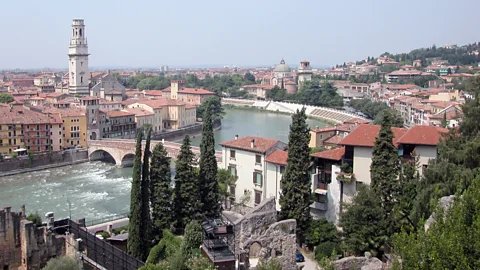
An increase in Chinese travellers to Europe puts off-the-beaten-path destinations, like Verona, Italy and Trier, Germany, on the map of a new Grand Tour.
China now sends more tourists abroad than any other Asian country.
According to the China Daily, this is a recent
development, with 70%
of all outbound trips from China taking
place within the past six years. In particular, Chinese travellers are gaining
recognition for their off-the-beaten-path exploration of Europe.
Since
Chinese tourists spend
more than 63.5 billion yuan abroad each year, they constitute a highly
coveted demographic for European tourism agencies. In 2009 alone, Chinese
tourists to France spent more than 1,000 euros per person per trip. This year, the industry-leading tourism
fair ITB Berlin even held a conference called “The
New Chinese Tourist: How to cater, reach and connect to a new breed of
sophisticated Chinese consumers”.
So where
exactly are Chinese travellers going when they visit Europe? Their version of
the Grand Tour includes some history, some culture and a whole lot of shopping.
History detectives
In Germany,
the less traversed city of Trier is seeing a bump thanks to the Chinese tourism
boom. The city is home to the Karl Marx Haus Museum, which pulls in 13,000 visitors from China annually.
In France,
historical tourism takes Chinese visitors to Montargis, a small town that helped lay the foundation for the Chinese Communist Party. Li
Shizeng, the son of a counsellor to the Chinese emperor, studied in Montargis in
the early 1900s. There, he founded the Work-Studies Movement, through which other students and intellectuals, including friends of
Mao Zedong, ended up in Montargis as well. In 1920, one man living there, Tsai
Hesen, wrote a letter to Mao discussing the formation of
the Chinese Communist Party. This piece of history has made Montargis a frequented
stop on some organized Chinese tours of France.
A more
romantic tourist attraction can be found at King’s College
in Cambridge, England. There, Chinese visitors flock to a willow tree made famous by the Chinese poet Xu
Zhimo. The poet studied at King’s College and wrote about the tree in his 1928
poem On leaving Cambridge.
Bonn,
Germany attracts classical music fans for being the birthplace of Ludwig van
Beethoven. Bonn is home to the Beethoven Haus, a museum with the world’s most
exhibits dedicated to the composer.
Lovers of
William Shakespeare head to Verona, the Italian city that was the backdrop for the
play Romeo and Juliet. There, tourists can see Juliet’s balcony, part of the 13th-century
mansion of the Capello family – upon whom Shakespeare’s Capulet family may have
been based. According to The Economist, Romeo and Juliet is especially
beloved in China because its story bears resemblance to a Chinese folk tale
called Butterfly Lovers.
In France, cultural
stops include far more expected attractions, including the Louvre, Versailles
and the Eiffel Tower.
Material girls and boys
According
to the European Travel Commission, one-third of Chinese travellers’ budgets are allotted for shopping. In 2010, tourists from China spent
193.9 billion pounds on London’s Bond Street alone.
More high-end
shopping can be found in Germany and France. In Metzingen, Germany, the Hugo
Boss factory outlets
are extremely popular, while in Paris, Louis Vuitton draws tourists in droves. True, many of the
luxury goods found in Europe are in fact made in China, but, as The Economist points out, European brand bags, watches and
wallets are 40% more expensive in China – and sometimes even those are
knock-offs.
In France,
Bordeaux is another city frequented by Chinese tourists – especially rich
Chinese businessmen interested in shopping for expensive bottles of red wine.
The superrich are occasionally invited to visit the Château Lafite Rothschild (which is not open to the general public).
Interestingly,
the Chinese’s interest in wine does not translate to an interest in European
cuisine, as they opt to take nearly all meals at Chinese restaurants. A 2006
survey, for instance, found that 46% of Chinese coach travellers had
only tried European food once
during their trip.
This may be
because many Chinese tourists use travel as a way to learn about their own culture,
as much as the culture of the place they are visiting. For more insight into
how Chinese travellers are experiencing Europe, this
New Yorker story guides readers from start to finish of the new Grand Tour.